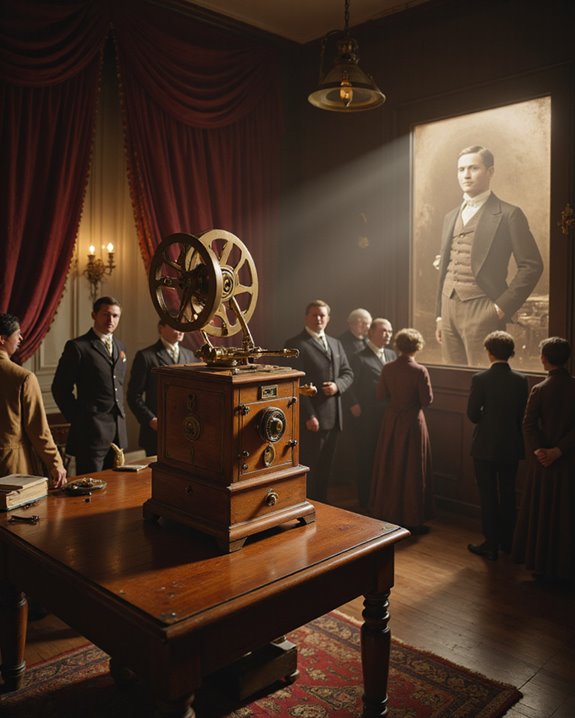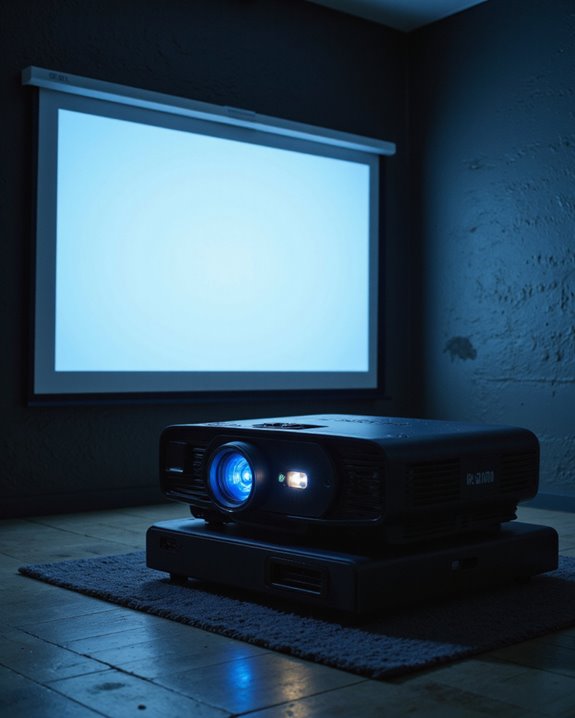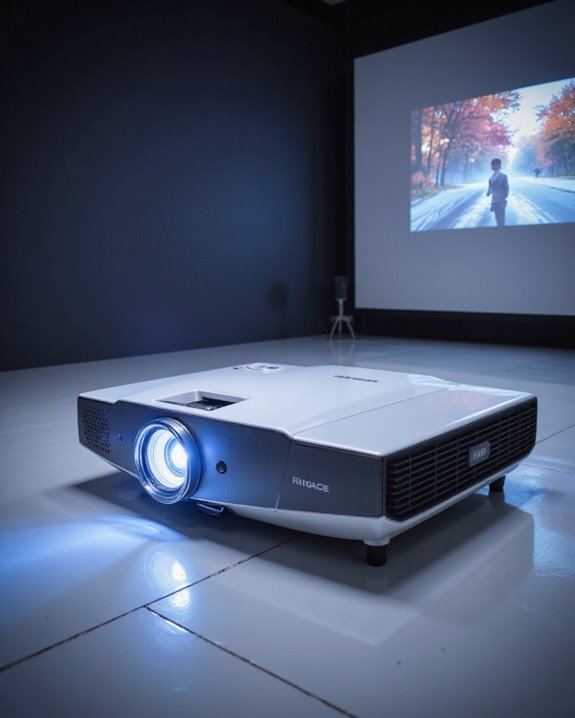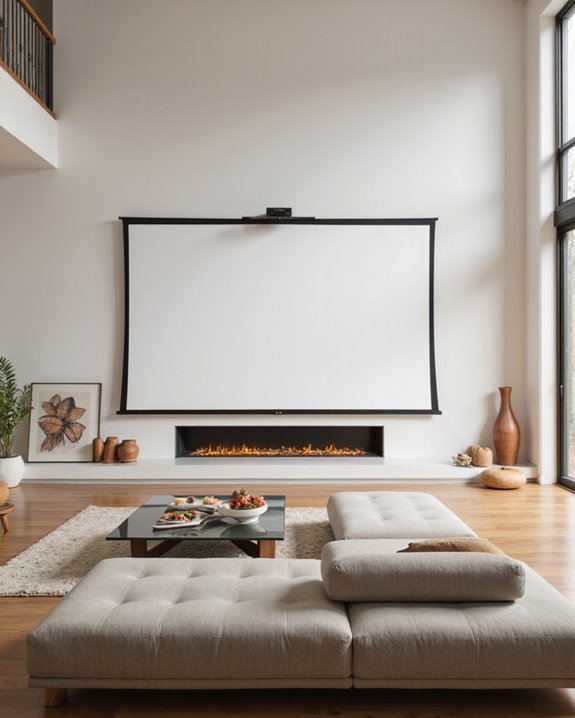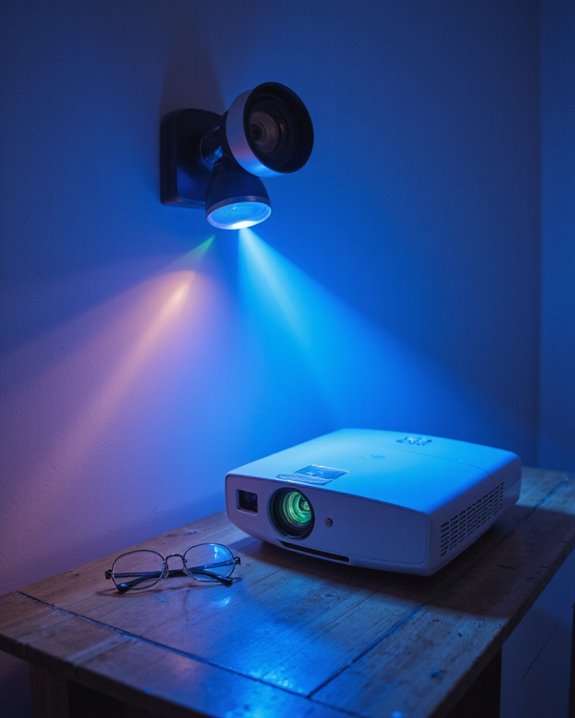Projection devices were firmly established by 1899, with several major technologies already in widespread use. The magic lantern, dating back to the 1650s, laid the foundation for more advanced systems. The Lumière brothers’ Cinématographe (1895) and Edison’s Vitascope marked significant breakthroughs in public film projection. These devices could display moving images to large audiences at 16 frames per second, using mechanical innovations like the Latham loop to prevent film damage. The evolution of projection technology transformed entertainment in ways that still influence modern cinema.
Key Takeaways
- By 1899, multiple projection technologies existed, including the Lumière Cinématographe and Edison’s Vitascope, capable of showing films to large audiences.
- Magic lanterns, dating back to the 1650s, were widely used throughout the 1800s for projecting still images and simple animations.
- The Lumière brothers revolutionized projection in 1895 with their Cinématographe, operating at 16 frames per second with a claw mechanism.
- Between 1887-1894, projection technology rapidly evolved from peep-show devices to large-scale entertainment systems for public screenings.
- Early projectors incorporated innovative features like the Latham loop and intermittent movement mechanisms to prevent film breakage during screenings.
The Birth of Early Projection Devices
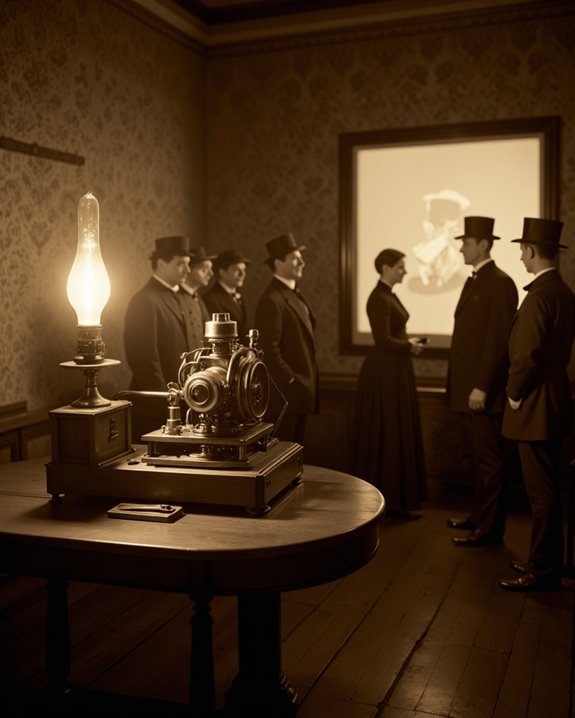
How did the earliest projection devices emerge from simple experimentation to revolutionary entertainment technology? The transformation began in 1887 when Ottomar Anschütz developed the Electrotachyscope, a groundbreaking device that displayed chronophotographic images through stroboscopic flashes.
The evolution of projection technology accelerated rapidly between 1887 and 1894. While early silent films relied on individual viewing through peep-shows, inventors quickly recognized the potential of showing moving images to larger audiences. Siemens & Halske’s 1891 manufacturing of coin-operated peep-box versions marked a vital step toward widespread adoption. The magic lantern, developed in the 1650s, had paved the way for these later projection innovations. Before modern color processes existed, these early devices used glass plates illuminated by continuous light sources. By 1894, Anschütz had introduced the first projector capable of entertaining larger groups, setting the foundation for modern cinema projection systems. Additionally, advancements in projection optics played a significant role in enhancing image clarity and brightness.
Major Breakthrough: The Lumière Brothers’ Legacy
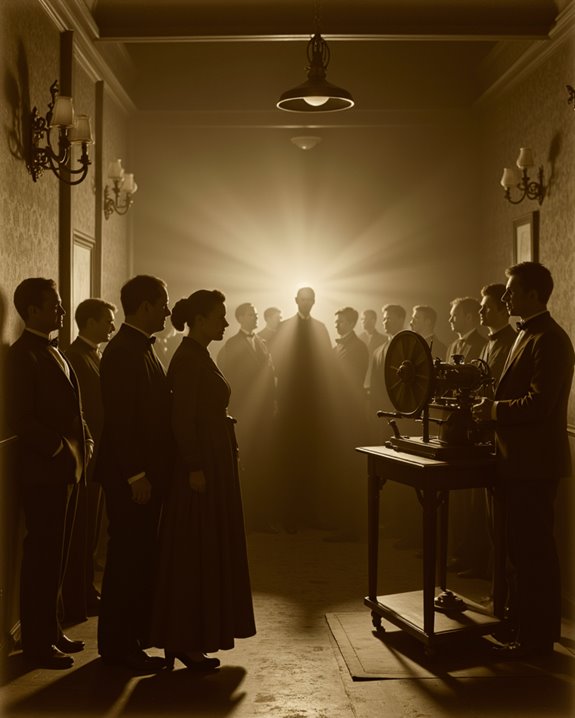
The invention of the Cinématographe by Auguste and Louis Lumière in 1895 marked a pivotal moment in cinema history. This revolutionary device combined three essential functions: camera, printer, and projector, setting a new standard in cinematography history. Operating at 16 frames per second, the Cinématographe’s innovative claw mechanism became fundamental to future film technology.
The device’s debut at Paris’s Grand Café on December 28, 1895, demonstrated its technological evolution beyond Edison’s Kinetoscope. Unlike earlier inventions that limited viewing to one person, the Cinématographe could project to large audiences. The Lumière Brothers showcased their invention worldwide, cementing its influence on the emerging film industry. Their contribution extended beyond motion pictures, as they later developed the Autochrome Lumière, an important advancement in color photography. The brothers’ early work included creating films about daily life, capturing everything from factory workers to city streets. The development of projection technology was a major breakthrough that allowed cinema to grow into a popular entertainment form.
Edison’s Impact on Projection Technology
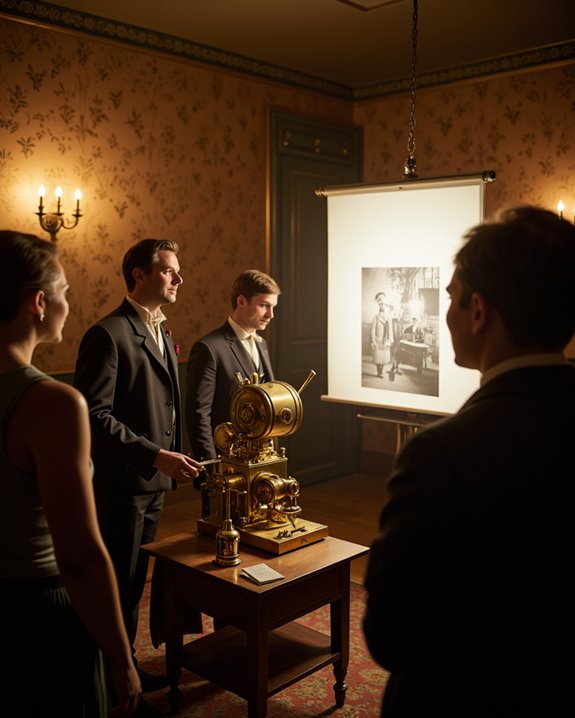
While Thomas Edison’s Kinetoscope revolutionized individual film viewing in 1891, his journey into projection technology marked a complex shift in cinema’s evolution. Initially hesitant to abandon the profitable single-viewer format, Edison’s company faced mounting pressure as projection systems gained popularity. The device’s development began with Edison filing a caveat in 1888 to create a visual motion apparatus similar to his phonograph. The early projectors incorporated advanced smart features such as automatic keystone correction and auto focus, aiming to improve user convenience and setup ease.
Technical Innovations That Changed Everything
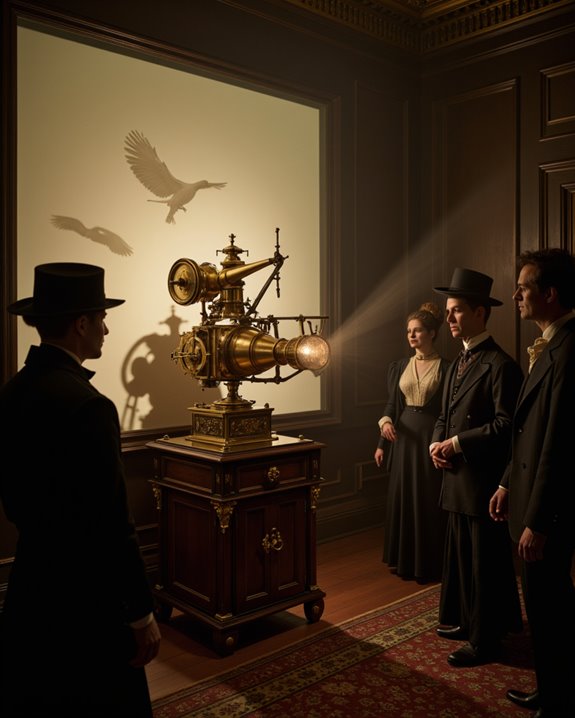
Major technical breakthroughs in projection technology transformed early cinema from a novelty into a revolutionary entertainment medium between 1889 and 1899. Optical principles from the ancient camera obscura combined with new mechanical innovations to create increasingly sophisticated projection systems. Early projection origins can be traced back to the Han Dynasty, which utilized shadows and mirrors to create artistic displays.
The introduction of celluloid film by Kodak in 1889 provided a flexible, durable medium that could capture longer sequences than ever before. Critical mechanical developments included the intermittent movement mechanism, which advanced film frame-by-frame while reducing blur, and the Latham loop that prevented film breakage during projection. The Lumière brothers’ cinématographe and Edison’s Vitascope further refined these innovations, creating devices that could both film and project motion pictures. These advancements culminated in the first public film screenings of 1895-1896, establishing cinema as a viable form of mass entertainment.
Public Reception and Cultural Impact
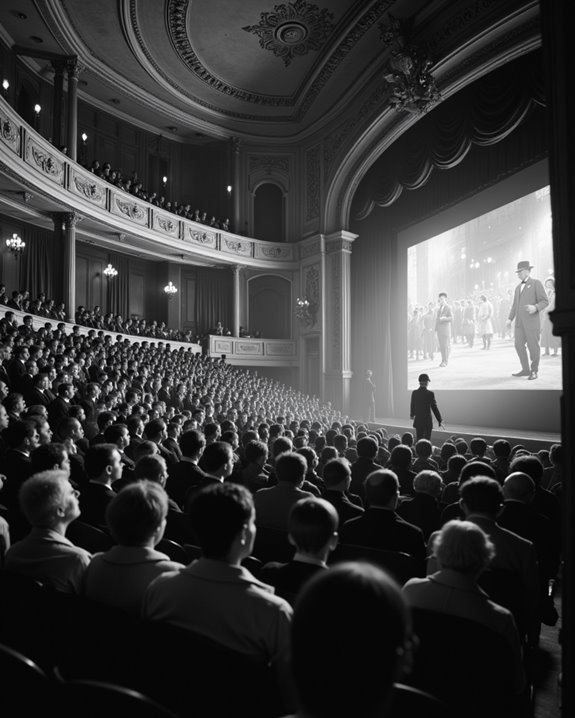
How did early audiences respond to the revolutionary capabilities of projection technology? By 1899, magic lanterns had become a powerful force for audience engagement, fascinating viewers in both public and private settings. The technology’s cultural significance extended far beyond mere entertainment, fostering community connections through shared viewing experiences.
People gathered in homes, lecture halls, and public spaces to witness projected images that brought stories to life. The technology’s ability to visualize complex concepts made it valuable for education, while its artistic applications opened new possibilities for creative expression. The red lacquered globular designs of home projectors like the lampascope added an elegant decorative element that helped them blend seamlessly into Victorian households. The public viewed these projectors as technological marvels, leading to increased awareness and appreciation of scientific advancement. This widespread adoption helped facilitate cultural exchange, allowing audiences to experience different perspectives through projected imagery.
Competing Technologies in the Late 1800s
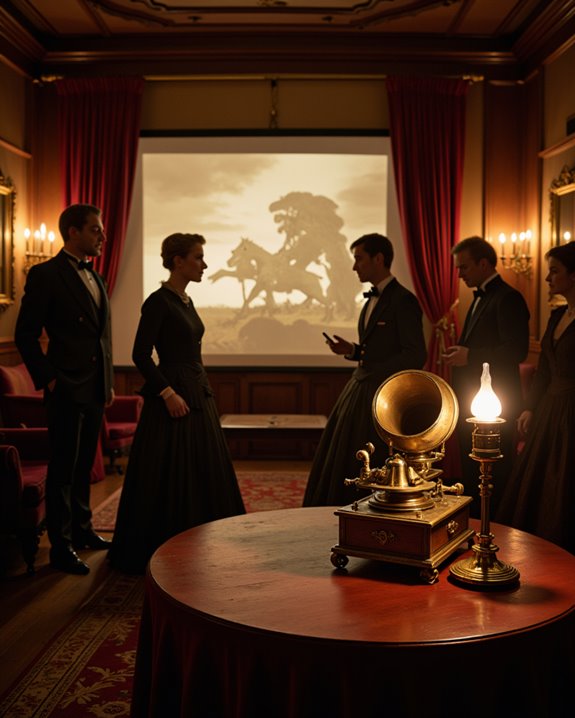
The late 1800s marked an intense period of competition among projection innovators, each endeavoring to create the most effective motion picture viewing experience. Edison’s Kinetoscope introduced perforated film for individual viewing, while the Cinematograph, invented by Leon Bouly, enabled public screenings of silent films. The Biograph distinguished itself by using non-perforated film, producing sharper images before color processes were developed. The Lumière brothers debuted their groundbreaking public film projection on December 28, 1895, at the Grand Café, setting a new standard for theatrical exhibition.
Each technology offered unique advantages. The Phantoscope, later renamed Vitascope by Edison, pioneered public projection methods, while the Mutoscope provided a more affordable, flip-book style alternative. These competing systems utilized different technical approaches, from the sprocketed film movement of the Kinetograph to the intermittent movement mechanism that became standard in modern projectors. Electric lamps enhanced image visibility, marking a significant advancement in projection capability.
The Rise of Public Film Screenings

Public film screenings revolutionized entertainment in the mid-1890s, transforming motion pictures from individual viewing experiences into communal events. The first commercial presentation occurred at the Holland Brothers’ Kinetoscope Parlor in New York City on April 14, 1894, where silent films cost 5 cents per view.
Early venues included saloons and theaters, which quickly became social hubs for diverse audiences. The Lumière brothers’ screenings in Paris during late 1895 marked a pivotal turning point in cinema history. Local exhibitors often enhanced these screenings with live spoken explanations to help audiences understand the content. Audience engagement grew as projection technology improved, particularly with innovations like the Latham Loop, which prevented film from tearing during projection. Content varied widely, featuring:
- Clothed female dancers
- Sparring boxers
- Everyday scenes
This accessibility and variety helped establish film as a mainstream entertainment medium.
Early Projection Pioneers and Their Contributions
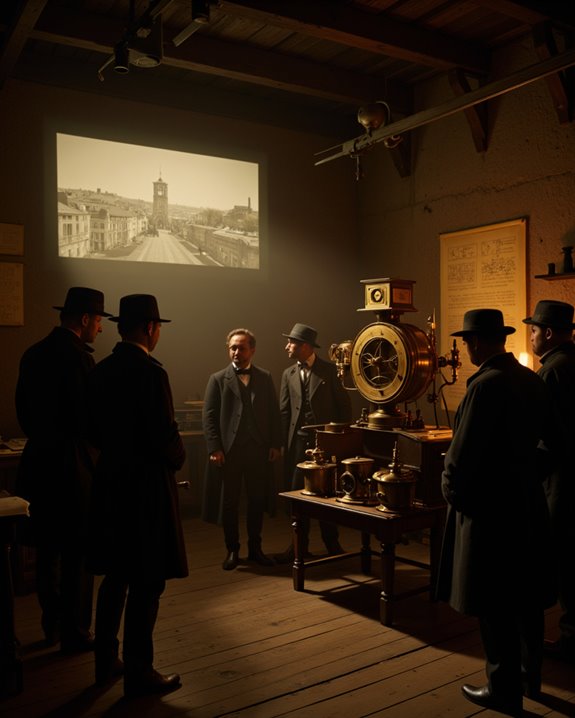
Brilliant inventors and innovators shaped the landscape of early cinema through their groundbreaking projection technologies. During the late 1800s, pioneers like Charles Francis Jenkins developed mechanisms for illuminating individual frames, laying the foundation for silent films. Thomas Edison marketed the Vitascope, while Thomas Armat contributed to its technical development.
The Lumière Brothers revolutionized the field with their Cinématographe, which combined filming, processing, and projection capabilities in one portable device. William K. L. Dickson‘s work on the Kinetograph and Kinetoscope proved essential for capturing and viewing motion pictures, though early color processes were still years away. Jenkins’ invention of the Phantoscope projector in 1893 marked a significant advance by allowing longer illumination of each film frame. These innovators’ combined efforts transformed entertainment from individual viewing experiences to public screenings, establishing the groundwork for modern cinema. Their achievements in projection technology sparked a cultural revolution that would forever change how people consumed visual media.
Frequently Asked Questions
How Much Did Early Projector Operators Get Paid for Their Work?
Early projectionist wages typically ranged from $1 to $5 per day, varying by region and skill level. Early operator salaries aligned with skilled labor rates, though specific documentation of their exact compensation remains limited.
What Were the Common Safety Hazards Associated With Early Film Projectors?
Early film projectors posed significant fire hazards due to flammable nitrate film and hot arc lamps. Operators faced risks of mechanical injuries from equipment malfunctions, film jams, and burns during projection operations.
How Long Did It Typically Take to Repair Early Projection Equipment?
While projection repair could take an eternity to complete, typical repair times ranged from several hours to multiple days, depending on part availability and technician wages, which influenced service speed and quality.
What Materials Were Used to Make Projection Screens in the 1890S?
Common projection screen materials in the 1890s included white sheets, theatrical fabrics, and painted glass. Vintage display fabrics were often chosen for their light-reflecting properties and durability in permanent installations.
How Did Weather Conditions Affect Outdoor Film Projections in the 1890S?
With nearly 100% of early film screenings occurring indoors, outdoor projection challenges were rarely documented in the 1890s. Weather impact remained largely theoretical, as cinema technology was specifically designed for controlled indoor environments.

